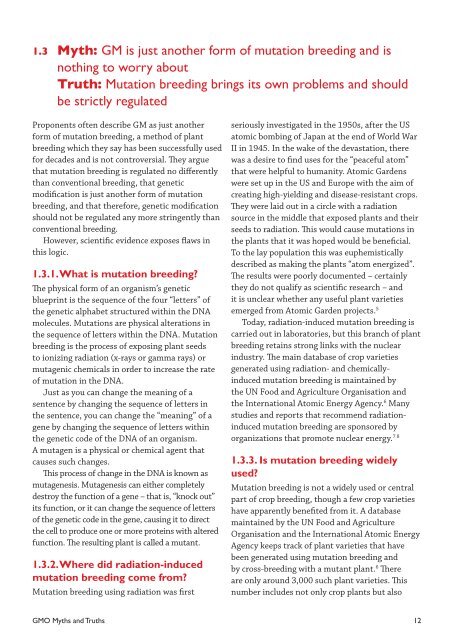GMO Myths and Truths
GMO Myths and Truths
GMO Myths and Truths
Create successful ePaper yourself
Turn your PDF publications into a flip-book with our unique Google optimized e-Paper software.
1.3 Myth: GM is just another form of mutation breeding <strong>and</strong> is<br />
nothing to worry about<br />
Truth: Mutation breeding brings its own problems <strong>and</strong> should<br />
be strictly regulated<br />
Proponents often describe GM as just another<br />
form of mutation breeding, a method of plant<br />
breeding which they say has been successfully used<br />
for decades <strong>and</strong> is not controversial. They argue<br />
that mutation breeding is regulated no differently<br />
than conventional breeding, that genetic<br />
modification is just another form of mutation<br />
breeding, <strong>and</strong> that therefore, genetic modification<br />
should not be regulated any more stringently than<br />
conventional breeding.<br />
However, scientific evidence exposes flaws in<br />
this logic.<br />
1.3.1. What is mutation breeding?<br />
The physical form of an organism’s genetic<br />
blueprint is the sequence of the four “letters” of<br />
the genetic alphabet structured within the DNA<br />
molecules. Mutations are physical alterations in<br />
the sequence of letters within the DNA. Mutation<br />
breeding is the process of exposing plant seeds<br />
to ionizing radiation (x-rays or gamma rays) or<br />
mutagenic chemicals in order to increase the rate<br />
of mutation in the DNA.<br />
Just as you can change the meaning of a<br />
sentence by changing the sequence of letters in<br />
the sentence, you can change the “meaning” of a<br />
gene by changing the sequence of letters within<br />
the genetic code of the DNA of an organism.<br />
A mutagen is a physical or chemical agent that<br />
causes such changes.<br />
This process of change in the DNA is known as<br />
mutagenesis. Mutagenesis can either completely<br />
destroy the function of a gene – that is, “knock out”<br />
its function, or it can change the sequence of letters<br />
of the genetic code in the gene, causing it to direct<br />
the cell to produce one or more proteins with altered<br />
function. The resulting plant is called a mutant.<br />
1.3.2. Where did radiation-induced<br />
mutation breeding come from?<br />
Mutation breeding using radiation was first<br />
seriously investigated in the 1950s, after the US<br />
atomic bombing of Japan at the end of World War<br />
II in 1945. In the wake of the devastation, there<br />
was a desire to find uses for the “peaceful atom”<br />
that were helpful to humanity. Atomic Gardens<br />
were set up in the US <strong>and</strong> Europe with the aim of<br />
creating high-yielding <strong>and</strong> disease-resistant crops.<br />
They were laid out in a circle with a radiation<br />
source in the middle that exposed plants <strong>and</strong> their<br />
seeds to radiation. This would cause mutations in<br />
the plants that it was hoped would be beneficial.<br />
To the lay population this was euphemistically<br />
described as making the plants “atom energized”.<br />
The results were poorly documented – certainly<br />
they do not qualify as scientific research – <strong>and</strong><br />
it is unclear whether any useful plant varieties<br />
emerged from Atomic Garden projects. 5<br />
Today, radiation-induced mutation breeding is<br />
carried out in laboratories, but this branch of plant<br />
breeding retains strong links with the nuclear<br />
industry. The main database of crop varieties<br />
generated using radiation- <strong>and</strong> chemicallyinduced<br />
mutation breeding is maintained by<br />
the UN Food <strong>and</strong> Agriculture Organisation <strong>and</strong><br />
the International Atomic Energy Agency. 6 Many<br />
studies <strong>and</strong> reports that recommend radiationinduced<br />
mutation breeding are sponsored by<br />
7 8<br />
organizations that promote nuclear energy.<br />
1.3.3. Is mutation breeding widely<br />
used?<br />
Mutation breeding is not a widely used or central<br />
part of crop breeding, though a few crop varieties<br />
have apparently benefited from it. A database<br />
maintained by the UN Food <strong>and</strong> Agriculture<br />
Organisation <strong>and</strong> the International Atomic Energy<br />
Agency keeps track of plant varieties that have<br />
been generated using mutation breeding <strong>and</strong><br />
by cross-breeding with a mutant plant. 6 There<br />
are only around 3,000 such plant varieties. This<br />
number includes not only crop plants but also<br />
<strong>GMO</strong> <strong>Myths</strong> <strong>and</strong> <strong>Truths</strong> 12


